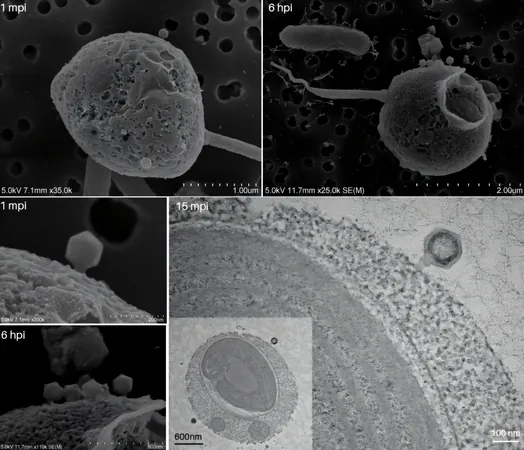
Meet PelV-1: The Giant Virus with a Tail Longer Than Your Imagination!
2025-08-10
Author: Sarah
A Groundbreaking Discovery in Marine Virology
Scientists from the University of Hawai'i at Mānoa have made waves in the world of marine microbiology with the discovery of PelV-1, a colossal virus that infects dinoflagellates. This giant virus boasts an astonishing tail length of 2.3 micrometers—truly a record breaker in viral structure!
Unlocking the Mysteries of Ocean Ecosystems
Until now, the characterization of viruses infecting phytoplankton has been limited, leaving crucial gaps in our understanding of ocean ecosystems. Previous research identified only two large DNA viruses that infected Heterocapsa species, but neither had their genomes sequenced. PelV-1 now fills that gap, offering insight into a critical, yet unexplored, facet of marine life.
Delving Deep: The Research Behind PelV-1
In a study titled "A dinoflagellate-infecting giant virus with a micron-length tail," which premiered on the bioRxiv pre-print server, researchers utilized advanced electron microscopy and high-coverage sequencing techniques. Their investigations into PelV-1's infection process involved cultures sourced from Station ALOHA in the North Pacific Subtropical Gyre, an ideal location for examining global ocean dynamics.
Remarkable Structural Features
The findings reveal approximately 200 nanometer capsids, with intriguing morphotypes featuring two different appendages: the breathtaking 2.3 µm tail and a shorter, sturdier protrusion near a stargate capsid opening. Time-lapse electron microscopy indicated that while the tail is crucial for initial attachment, mature virus particles lose their tails once inside the host cell, suggesting a sophisticated assembly process after host lysis.
A Virulent Arsenal: Genetic Insights
PelV-1 and its rare companion virus, co-PelV, fall within the Mesomimiviridae family. Detailed analysis revealed a whopping 467 coding sequences plus nine tRNAs in PelV-1, while co-PelV offers 569 genes and 14 tRNAs. These genes are integral for various metabolic processes, including amino acid, carbohydrate, and lipid metabolism, alongside functionalities like light-harvesting complexes and aquaporins.
Implications for Plankton Ecology
The remarkable 2.3 µm tail not only makes PelV-1 a fascinating subject for study but may also enhance host encounter rates in nutrient-poor environments, sparking a need for further research. Understanding how such viral structures interact with and influence plankton ecology could transform our understanding of marine ecosystems.
A New Era in Marine Viral Research
PelV-1 is not just significant for its size; it dramatically expands the known morphological and genomic diversity of marine viruses. This discovery could pave the way for groundbreaking studies into the role of viruses in oceanic ecosystems, challenging our preconceptions about life in the water.



 Brasil (PT)
Brasil (PT)
 Canada (EN)
Canada (EN)
 Chile (ES)
Chile (ES)
 Česko (CS)
Česko (CS)
 대한민국 (KO)
대한민국 (KO)
 España (ES)
España (ES)
 France (FR)
France (FR)
 Hong Kong (EN)
Hong Kong (EN)
 Italia (IT)
Italia (IT)
 日本 (JA)
日本 (JA)
 Magyarország (HU)
Magyarország (HU)
 Norge (NO)
Norge (NO)
 Polska (PL)
Polska (PL)
 Schweiz (DE)
Schweiz (DE)
 Singapore (EN)
Singapore (EN)
 Sverige (SV)
Sverige (SV)
 Suomi (FI)
Suomi (FI)
 Türkiye (TR)
Türkiye (TR)
 الإمارات العربية المتحدة (AR)
الإمارات العربية المتحدة (AR)